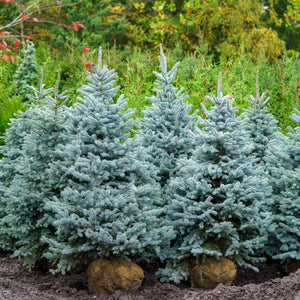The Spruce Guide
Spruce trees (Picea spp.) are iconic evergreens admired for their pyramidal form, sharp needles, and architectural impact in the landscape. With species ranging from towering natives like Picea abies to compact, colorful cultivars like Picea pungens 'Montgomery', spruces provide structure, privacy, and ornamental appeal in both residential and commercial settings. Whether used as a windbreak, specimen tree, or in a dwarf conifer garden, spruces offer year-round interest and exceptional adaptability.

About
The Picea genus includes over 30 species native to North America, Europe, and Asia. These conifers are characterized by stiff, needle-like leaves attached singly to the branches and cones that hang downward. Spruces are typically pyramidal in form, with dense branching and a strong central leader. Their adaptability to cold climates and varied soil conditions has made them a staple in northern landscapes.
Common species include:
- Picea pungens (Colorado Blue Spruce): Known for its silvery-blue needles and upright form. Cultivars like 'Hoopsii', 'Fat Albert', and 'Baby Blue Eyes' are popular in ornamental plantings.
- Picea abies (Norway Spruce): Fast-growing with graceful, drooping branch tips. Often used in windbreaks, it also includes weeping and dwarf cultivars such as 'Pendula' and 'Nidiformis'.
- Picea glauca (White Spruce): Native to North America and valued for its tolerance to cold and urban conditions. Compact varieties like 'Conica' are widely used in foundation plantings.
- Picea omorika (Serbian Spruce): Elegant, narrow habit with two-toned needles—dark green above and silver beneath. Great for tight spaces.
- Picea orientalis (Oriental Spruce): Glossy dark green needles and slower growth make this species ideal for refined landscapes.
From bold specimens to fine-textured groundcovers, spruces offer a wide range of forms and colors, including blue, gold, lime, and deep green. Many cultivars remain compact and manageable, fitting into rock gardens, containers, or urban yards.

PLANTING
USDA Hardiness Zones: Most spruces are hardy in Zones 2–7. Some varieties extend into Zone 8, while others are best suited to cooler northern climates.
Soil: Prefers well-drained, loamy soil but tolerates sandy or clay soils. Avoid poorly drained or consistently wet sites.
Sunlight: Full sun (6+ hours daily) is essential for healthy needle color and dense growth. Partial shade may reduce vigor and form.
Watering: Water regularly during establishment. Once established, spruces are drought tolerant but benefit from deep watering during prolonged dry periods.
Spacing: Spacing depends on mature size. Large trees like Picea abies may need 20–30 feet of spacing, while dwarf cultivars can be spaced 3–6 feet apart.
Planting Time: Early spring or fall is best. Avoid planting in midsummer heat or during frozen winter conditions.

CARE
Watering: Deep, infrequent watering is best. Established spruces typically require little supplemental irrigation, but monitor during droughts.
Fertilizing: Apply a balanced, slow-release fertilizer in spring if growth is weak. Avoid excessive fertilization, which can lead to weak branching.
Pruning: Minimal pruning is needed. Remove dead or damaged branches in late winter. Light shaping can be done in early spring, but avoid cutting into old wood.
Pests and Diseases: Common issues include spruce spider mites, needle cast diseases (like Rhizosphaera), and bagworms. Inspect regularly and treat promptly if symptoms arise.
Mulching: Apply 2–3 inches of mulch around the base to conserve moisture and protect roots. Keep mulch a few inches away from the trunk.

HOW TO USE
Focal Point Specimens: Larger cultivars like Picea pungens 'Hoopsii' or Picea abies 'Pendula' make striking focal points in open lawns or mixed conifer plantings.
Privacy Screens and Windbreaks: Use fast-growing species like Picea abies or Picea glauca for year-round privacy and shelter from wind. Their dense branches form effective barriers.
Foundation and Entry Plantings: Compact forms like Picea glauca 'Conica', Picea pungens 'Montgomery', or Picea abies 'Little Gem' are ideal for front yard accents and low-maintenance foundation beds.
Rock and Alpine Gardens: Miniatures and dwarfs such as Picea abies 'Tompa' or Picea pungens 'Globosa' add color and texture to rockeries and trough gardens.
Color Contrast: Gold and lime cultivars like Picea orientalis 'Skylands' or Picea abies 'Perry's Gold' contrast beautifully with deep greens and blue-toned plants.
Winter Interest: The evergreen structure of spruces adds backbone to the winter garden. Combine with red-twig dogwood, ornamental grasses, and evergreen perennials for dynamic cold-season displays.

Common Questions
How fast do blue spruce grow? Colorado Blue Spruce grows moderately, about 12–24 inches per year under ideal conditions.
What does a spruce look like? Spruce trees are conical evergreens with stiff, sharp needles and downward-hanging cones. Branches are arranged in whorls, creating a symmetrical form.
How fast do spruces grow? Growth rates vary. Norway Spruce can grow 2–3 feet per year, while dwarf cultivars may only grow a few inches annually.
How to plant a spruce? Dig a hole twice as wide as the root ball but no deeper than the container. Set the tree slightly above grade, backfill with native soil, water thoroughly, and mulch.
Do deer eat spruce? Spruces are generally deer resistant due to their sharp needles, though young plants may be nibbled in harsh winters.
Do spruces need full sun? Yes, most spruces require full sun for optimal growth, density, and color.
How big do spruces get? Depending on species and cultivar, spruces range from 2-foot miniatures to 60-foot giants.
How long do spruces live? Spruce trees are long-lived, often surviving 100 years or more in ideal conditions.
Conclusion
Spruce trees are durable, striking, and highly diverse evergreens that enhance landscapes with year-round structure and beauty. With forms ranging from towering giants to compact mounds, there’s a spruce for every design style and space. Whether you're looking to create a windbreak, a winter focal point, or a colorful conifer garden, spruces deliver dependable performance with minimal upkeep.
The Spruce Collection
Sold Out
Sold Out
Sold Out
Sold Out




